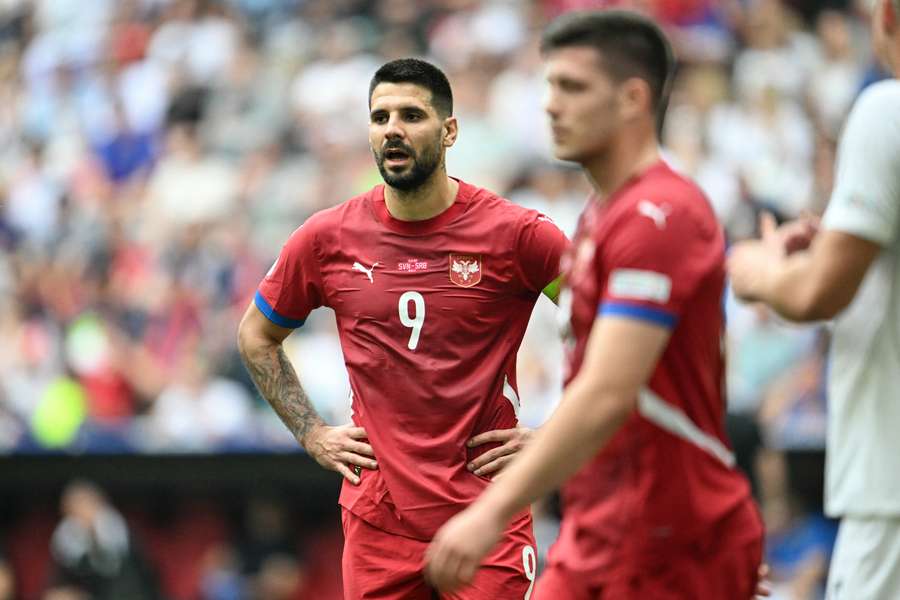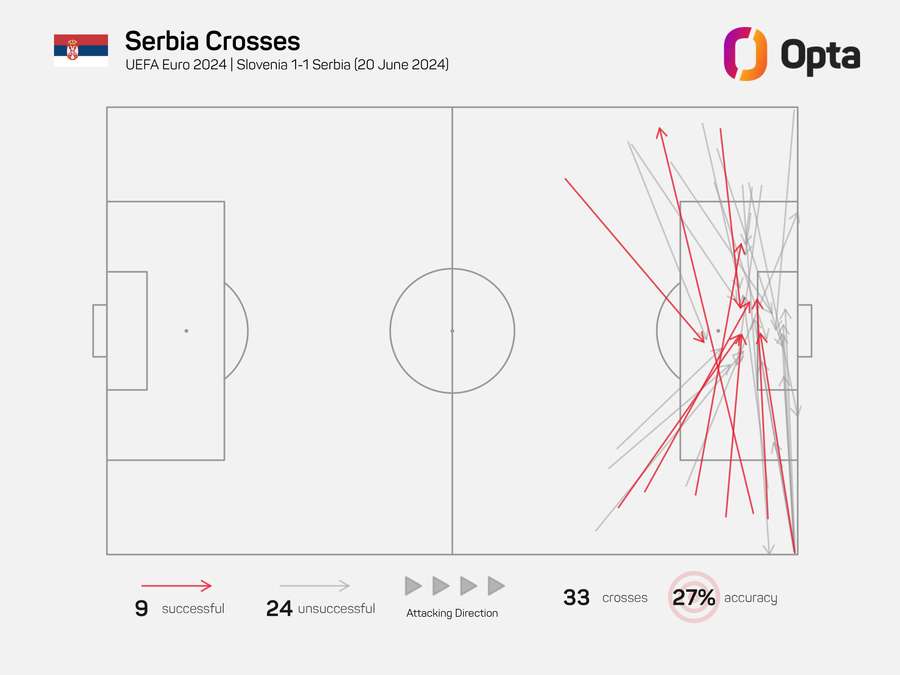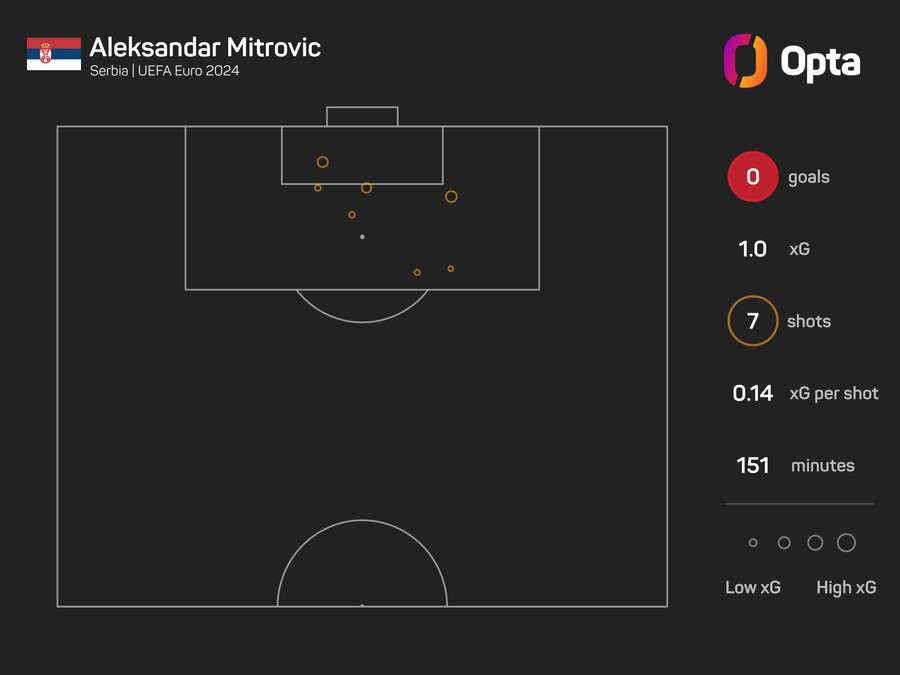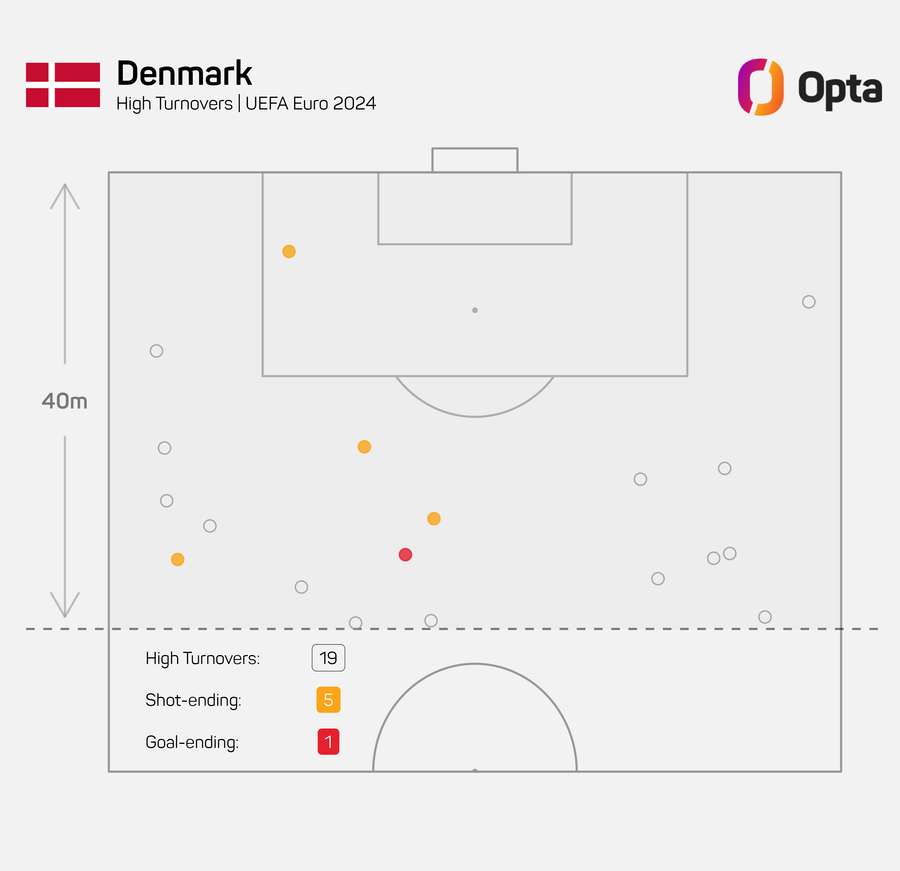Serbia and Denmark prepare for crucial Group C clash at Euro 2024

For both, a win would guarantee a place in the next round, whereas a draw could in the case of Denmark and would in the case of Serbia spell trouble.
A crossing point
So far, the tournament has not really gone Serbia’s way. After losing the opener to England after a Jude Bellingham header, Dragan Stojkovic’s team then struggled to break down the surprising Slovenians.
In a group where goals are a hot commodity (no group has seen fewer goals over the first two matchdays than Group C, seven), Serbia will have to find ways to generate better chances, as only four teams have had a lower Expected Goals-tally than the Serbs so far (1.8).
Most of that came against Slovenia. After a tepid display against England, resulting in the tournament’s lowest single-game xG (0.18), Serbia attempted to breach the opponent’s defence by playing lots of crosses. The 33 attempted crosses (including corners) against Slovenia were the second highest by a team in a Euros game this tournament.

And the final one proved Stojkovic right as Luka Jovic headed home Ivan Ilic’s ball. Against the Danes, that gameplan is unlikely to change, as the Serbs field potentially one of the most impactful target men in the Euros.
Struggling strikers
In Aleksandar Mitrovic, Serbia host one of the most prolific players in international football. In fact, since the turn of the decade, he has proven himself among other illustrious goalscorers for their country, ranking seventh for goals scored among European players.

This tournament however, Mitrovic is keeping himself in good stead with his peers by being a known goal threat that just doesn’t seem to be able to find the net. Only two players had more shots over the first two matchdays of this tournament without scoring than Mitrovic (seven, after Cristiano Ronaldo with nine & Romelu Lukaku with eight).
Six of those shots came against Slovenia, with four coming from crosses. Aleksandar Mitrovic had and missed three big chances that game, becoming only the second player this tournament with three such chances in a game while scoring none, after Romelu Lukaku against Slovakia.

But at least Mitrovic is getting chances. Rasmus Hojlund has been struggling for both club and country, scoring just three goals in his last 19 games for Denmark and Manchester United. And it is especially in the shirt of Denmark that the forward is just not getting any breaks. In his last six games for his country, he has recorded eight shots with a total value of 0.54 Expected Goals and created just one chance. None resulted in a goal or assist.
This tournament, Hojlund has just one shot over two games. Thankfully for him, that is still as many as all Danish substitutions have had combined (one shot from Mikkel Damsgaard v England). However, it seems the Danes have to rely on another Manchester United player to fire them to the second round.
Evergreen in midfield
Christian Eriksen has been the absolute star for Denmark so far this tournament. Against Serbia, Eriksen can break the tie for most caps for the Danish national team with Simon Kjær (both 132 games), although with the centre back still part of the squad, he might pull level not long after kick-off.
But despite being part of the Danish squad for well over 14 years now, Eriksen seems far from done. Over the first couple of matchdays, he either recorded (8) or created (11) 19 shots, at least four more than any other player in the tournament. At 32 years and 127 days, he became the oldest player with more than three created chances in back-to-back Euro games since Andrea Pirlo (33 years old in 2012).

Press and possession
Eriksen also does his part without the ball, as he is one of 29 players to have won possession more than 10 times over the first two matchdays and it is a welcome trait in the demanding playing style of Denmark manager Kasper Hjulmand. The Danish manager favours an approach with a lot of pressing, with the Danes ranking joint-second in terms of high turnovers (19) and fourth in terms of PPDA (10.4) after two matchdays.

Winning the ball aggressively, they’ve maintained their trademark style of passing the ball patiently this tournament, with only Germany, Portugal and Croatia having more possession (58.9%). But, as highlighted by the struggles of their striker Hojlund, they have failed to make that possession count. The Danes rank joint-fifth in shots with 32, but that is skewed a bit by the fact that they take the joint-third most shots from distance (14 so far) as well.
In total, the 32 shots accumulated a total of 2.48 Expected Goals, and the average of 0.078 Expected Goals per shot is the fourth lowest among teams in the Euros after two matchdays. One of the reasons for this could be the inability of the Danes to create man-more situations by dribbling past their opponent, as the team ranks dead last in terms of both successful dribbles (five, of 18) and success percentage from these situations (28%).
Breaking habits
With both teams a bit stale in attack, at least Denmark can rely on having the history between the two in their favour. The Danes won each of their previous three matches against the Serbs, scoring eight in total and conceding only once. However, Denmark have now failed to win any of their last six games in major tournaments (D3 L3), equalling their longest such streak from 1986-1992 (D1 L5).
Meanwhile, Serbia’s streak without a win in major tournaments now stands at seven (D2 L5). Can either break a bad habit and get a much-needed win this Tuesday?

